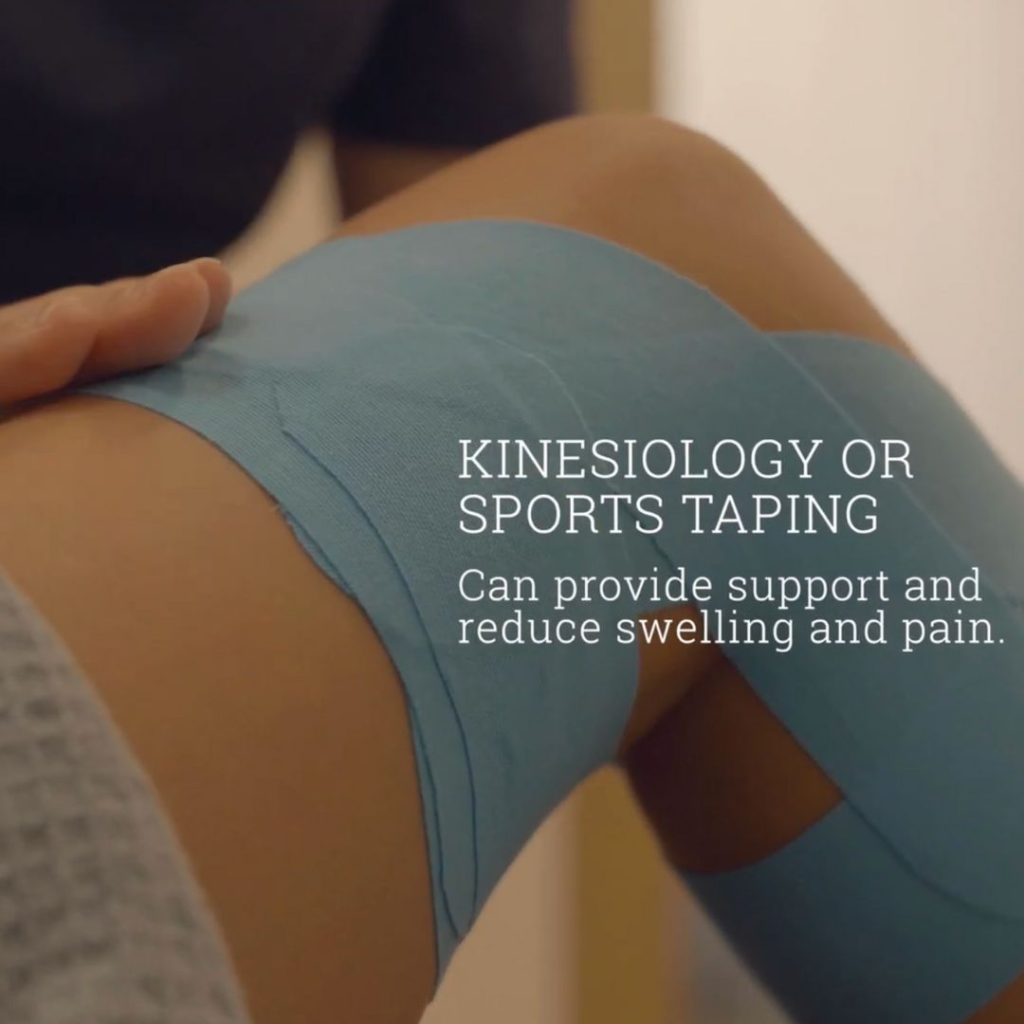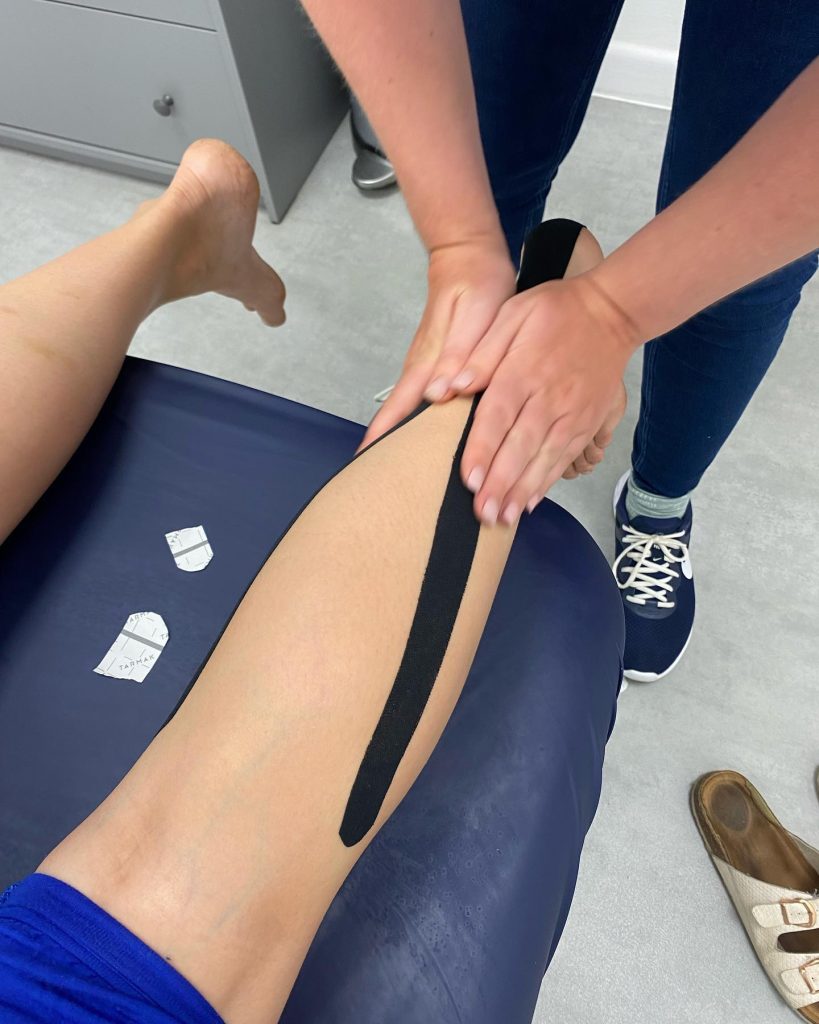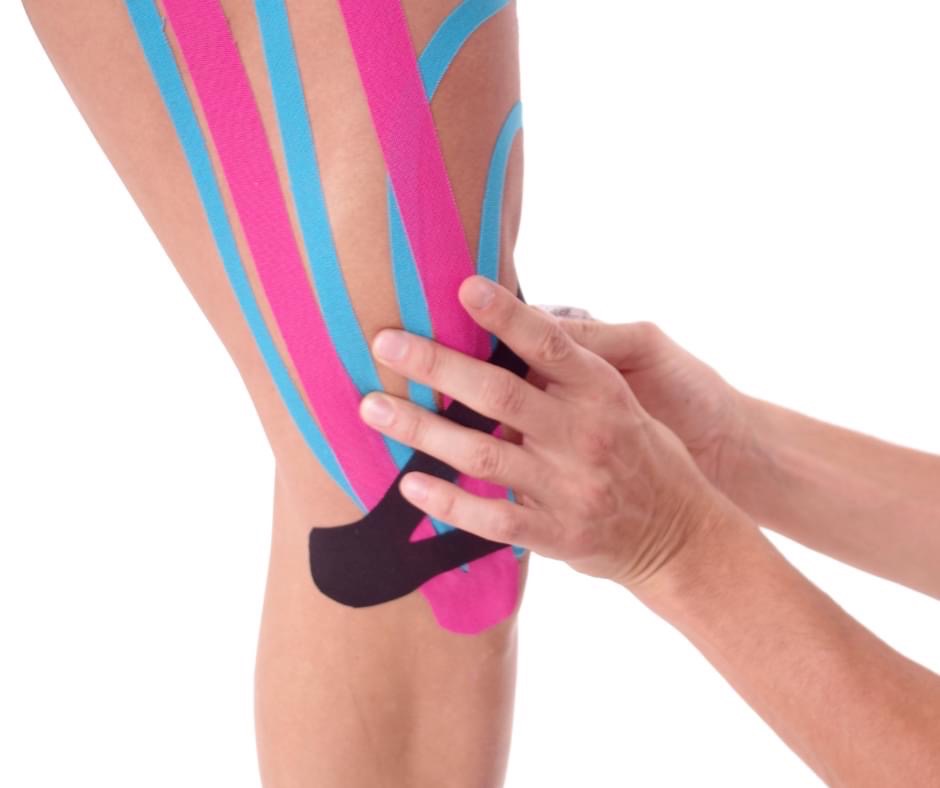
What is Kinesiology Taping
Kinesiology taping is a treatment option if you’ve had an injury or illness that leads to mobility and motor function problems. It involves placing strips of special tape on your body in specific directions to help support your joints, like a knee, ankle, or wrist, as well as muscles and tendons. It can be used to help facilitate muscle function, stabilize joints, or inhibit muscles from contracting improperly. It can also be used to help decrease pain, swelling, and muscle spasm.
What Does Kinesiology Taping Do?
……………..and how does it differ from athletic tape?
While kinesiology tape seems a lot like elastic athletic tape, there are differences between the two.
- Kinesiology tape is used to facilitate motion and inhibit pain and spasm, while athletic tape is used for support and to limit motion, typically because of existing pain.
- Kinesiology tape is a flexible material that moves when you move; athletic tape is relatively inflexible.
- Kinesiology tape helps to improve lymph transport and increase circulation. The tight binding nature of athletic tape serves to decrease circulation.


How Kinesiology Tape Works
There are different theories about how kinesiology tape works. First, it is thought to change the proprioception input of the sensory nervous system in the muscles, joints, and skin. This is the sensation that allows you to know where your body is in space (say, how high your arm is raised).
The tape is thought to improve the interaction between the skin and the underlying structures to help reset the circuitry of this part of the nervous system, resulting in improved muscular activation and performance.
Kinesiology tape is also thought to inhibit nociceptors (pain pathways) in your muscles, skin, and joint structures. Decreasing painful input to the brain is thought to normalize muscle tone, resulting in decreased pain and muscular spasm.
Kinesiology tape can be applied in different ways, depending on why it’s needed. Your physical therapist can show you how to use the tape and cut the adhesive strips into the right configuration.
Some of the taping types include:
- The “I” strip: This shape can be used to make the other types of strips below. “I” strips are used to support muscles, tendons, and ligaments. They are often used to facilitate your rotator cuff, gluteus muscles, quadriceps, or Achilles’ tendon. It can also be used on your low back and middle back to help you maintain proper posture.
- The “X” strip: This type is used when kinesiology tape is needed to cover a large area or cross multiple joints. The tabs of the “X” strip cross over sensitive areas such as the back of your knees or front of your elbows. This strip is commonly used to facilitate your hamstrings, which cross both your hip joint and the back part of your knee joint.
- The “Y” strip: This strip is used to cross sensitive areas of your body such as behind your knee or in the front of your elbow. It is also commonly used for applications to control the position of your kneecap. The “Y” strip is typically not as long as the “X” strip.
- The “fan” strip: This type can help control swelling of your leg or arm. It is commonly used in lymphedema management or for superficial contusions and swelling.7
- The “lift” strip: Commonly referred to as the Band-Aid, this strip is often used to support injured tissues or to treat muscle knots or trigger points. It helps to lift skin and tissues off sore muscles and trigger points. It is also used to treat superficial bruises.
Your therapist or sports medicine provider can ensure that you’re placing the tape in the proper position and that the tape is not too tight or restrictive. They’ll also let you know how long to wear the kinesiology tape.


Some specific uses of Kinesiology Tape
- Facilitation: Kinesiology tape can be used to help improve muscular firing and contraction patterns. This can lead to normalized muscular tone and can also help improve athletic performance.
- Inhibition and pain management: Kinesiology tape can be used to help decrease pain and muscle spasms that may occur after injury. It can help decrease nociceptive input to the brain which can help decrease muscle guarding and protective spasms.
- Support and stability: If you have a condition that requires a specific joint to be held in place, kinesiology taping may be right for you. Conditions like patellofemoral stress syndrome, iliotibial band friction syndrome or shoulder instability may benefit from extra support provided by kinesiology tape. The tape can support your joint while still allowing for some motion.
- Swelling management: If you have had swelling from an injury or surgery, kinesiology tape may help decrease the swelling by decreasing pressure between the skin and underlying tissues. This provides a pathway for excess fluids that have accumulated since your injury to travel through. Kinesiology tape is sometimes used in lymphedema management or for superficial contusions.
Your physical therapist may use various treatments and exercises to help treat your specific problem. Kinesiology tape may be a part of your treatment. Talk to your Osteopath or Sports Massage Therapist to learn about the tape and set realistic goals for its use.